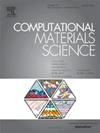Probing the structural evolution, electronic and spectral properties of bimetallic K2Mgn clusters: A DFT study
IF 3.3
3区 材料科学
Q2 MATERIALS SCIENCE, MULTIDISCIPLINARY
引用次数: 0
Abstract
We report a systemic exploration to determine the global minimum geometries of the K2Mgn (n = 1–12) clusters. This is accomplished by utilizing the CALYPSO code for geometric prediction, subsequently refined through DFT-based optimization. The results reveal a structural transition from planar to three-dimensional framework at n = 3, followed by the formation of a hollow cage-like structure at n = 8. This transition occurs slightly later compared to pure Mg clusters. The convex site is identified as the preferred localization point for K atoms within these structures. Additionally, there is a charge transfer from K to Mg, providing evidence for sp hybridization within the clusters. The stability study shows the outstanding stability of K2Mg3 and K2Mg9, which can be attributed to the closed-shell configurations of 1S21P6 and 1S21P61D102S2. Analysis of bonding characteristics highlights the delocalization of bonds in K2Mg3 and K2Mg9, in which there is much weaker K-Mg interaction than the Mg-Mg interaction. Finally, a comprehensive evaluation of the spectral properties, as characterized by IR and Raman spectroscopy, has been investigated.

双金属K2Mgn簇的结构演变、电子和光谱特性的DFT研究
我们报告了一项系统的探索,以确定K2Mgn (n = 1-12)簇的全局最小几何形状。这是通过利用CALYPSO代码进行几何预测来完成的,随后通过基于dft的优化进行改进。结果表明,在n = 3时,结构从平面过渡到三维框架,然后在n = 8时形成空心笼状结构。与纯Mg团簇相比,这种转变发生得稍微晚一些。在这些结构中,凸点被确定为K原子的首选定位点。此外,还有从K到Mg的电荷转移,为团簇内sp杂化提供了证据。稳定性研究表明,K2Mg3和K2Mg9具有突出的稳定性,这可归因于1S21P6和1S21P61D102S2的闭壳构型。化学键特征分析表明,K2Mg3和K2Mg9中存在键离域,其中K-Mg相互作用比Mg-Mg相互作用弱得多。最后,利用红外光谱和拉曼光谱对其光谱特性进行了综合评价。
本文章由计算机程序翻译,如有差异,请以英文原文为准。
求助全文
约1分钟内获得全文
求助全文
来源期刊

Computational Materials Science
工程技术-材料科学:综合
CiteScore
6.50
自引率
6.10%
发文量
665
审稿时长
26 days
期刊介绍:
The goal of Computational Materials Science is to report on results that provide new or unique insights into, or significantly expand our understanding of, the properties of materials or phenomena associated with their design, synthesis, processing, characterization, and utilization. To be relevant to the journal, the results should be applied or applicable to specific material systems that are discussed within the submission.
 求助内容:
求助内容: 应助结果提醒方式:
应助结果提醒方式:


